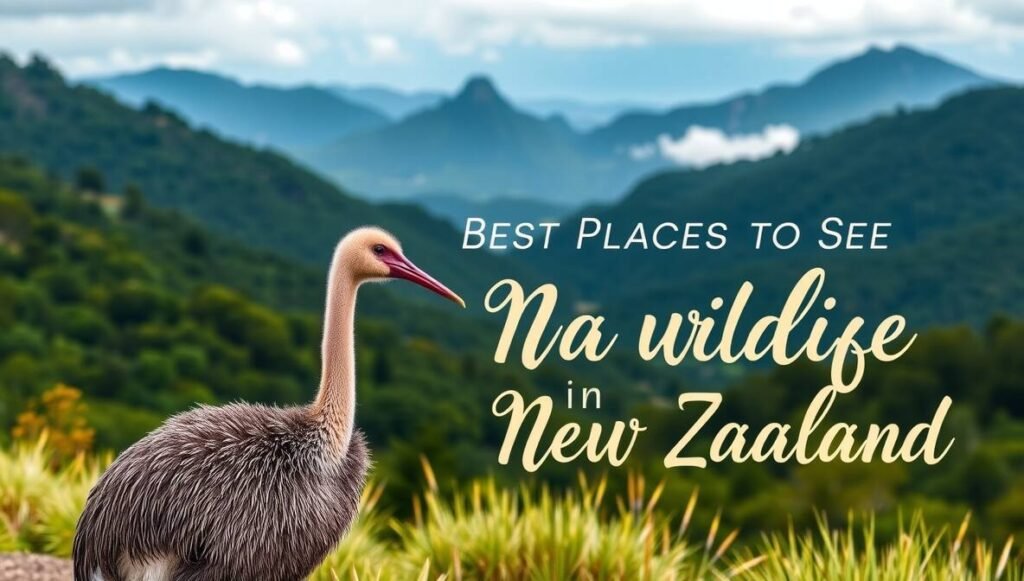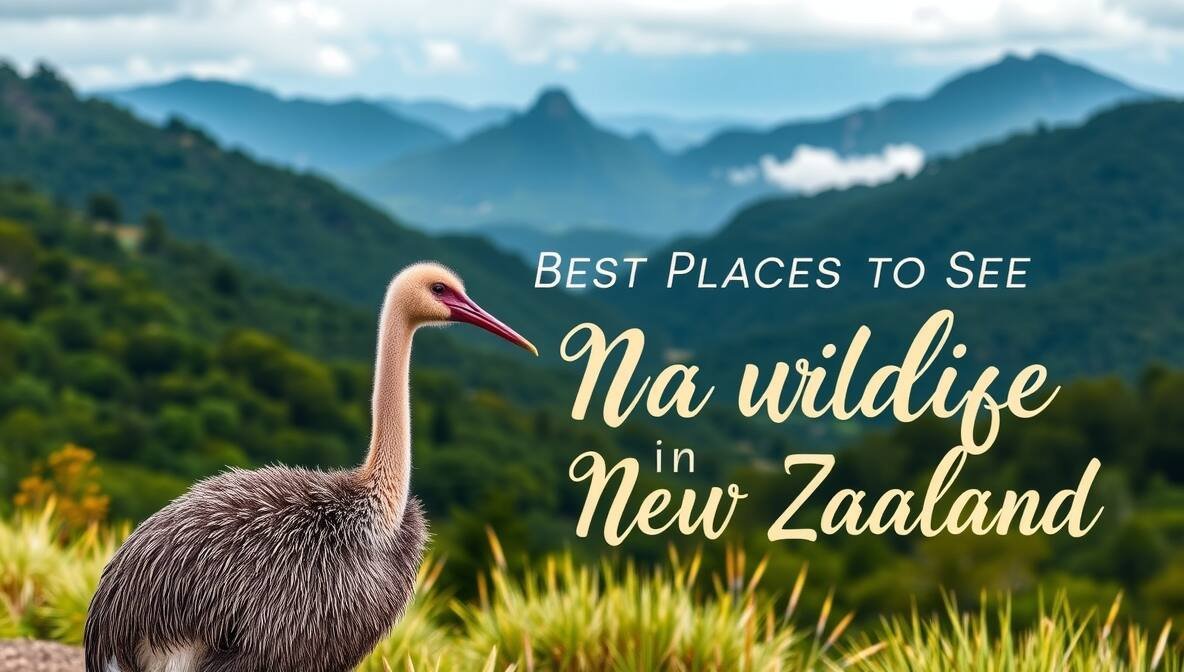New Zealand, known for its breathtaking landscapes, offers wildlife enthusiasts an adventure unlike any other. From rugged coastlines to lush rainforests and vast alpine regions, the country is home to some of the most incredible species found nowhere else on Earth. Famous for its conservation efforts and unique birdlife, New Zealand is considered one of the best places to see wildlife in New Zealand.
Whether you’re looking to spot the elusive kiwi bird, marvel at the acrobatics of dolphins, or witness massive colonies of albatross and seals, this island nation provides countless opportunities to immerse yourself in natural beauty. For anyone enchanted by nature’s wonders, New Zealand is truly a must-visit destination.

Why New Zealand Is the Best Place to See Wildlife
New Zealand’s wildlife diversity stems from its geographic isolation. Over millions of years, this remote nation developed a host of species that are endemic, meaning they are found nowhere else in the world. One of its most fascinating features is the dominance of bird species, many of which have adapted to life without predators, resulting in extraordinary behaviors and appearances.
The country’s commitment to conservation stands out. Initiatives like the Sanctuary Mountain Maungatautari and predator-free islands ensure the survival of native species such as the kiwi, takahe, and kakapo. New Zealand’s marine ecosystems are equally vibrant, with protected marine reserves that serve as havens for dolphins, orcas, and countless fish species.
Its commitment to eco-tourism has made wildlife conservation a key priority, allowing travelers to explore pristine habitats while supporting local communities and preservation causes. This combination of geographic uniqueness and dedicated care makes New Zealand one of the top wildlife spots in New Zealand.
Top Wildlife Spots in New Zealand
1. Stewart Island / Rakiura
About 85% of Stewart Island is a protected national park, making it a sanctuary for wildlife. It is one of the best places to see the rare kiwi bird in the wild, especially during guided nocturnal tours. Additionally, you may encounter seabirds like albatross and petrels along the coast and even spot sea lions on its tranquil beaches.
2. Kaikōura
Kaikōura is a coastal town famous for its stunning marine life. Its nutrient-rich waters attract sperm whales, orcas, dusky dolphins, and seals year-round. Whale-watching tours are a highlight here, as are boat trips designed for dolphin swimming. Kaikōura’s dramatic mountain-sea landscape makes it ideal for wildlife photography in New Zealand.
3. Kapiti Island
Just off the coast of the North Island, Kapiti Island is a predator-free reserve where native birds thrive. You’ll see tui, kaka, and weka in abundance as you hike the island’s trails. Overnight stays offer an even better chance to hear or see kiwi birds in their natural habitat.
4. Otago Peninsula
Located near Dunedin on the South Island, the Otago Peninsula is often regarded as a paradise for birdwatchers. Visitors can spot rare yellow-eyed penguins, the majestic royal albatross, and New Zealand fur seals along this coastline. Guided tours offer a closer look while adhering to eco-friendly principles.
5. Fiordland National Park
A crown jewel of the South Island, Fiordland National Park is world-renowned for its dramatic cliffs, fjords, and pristine forests. The area supports diverse birdlife, including the iconic kea (a mischievous alpine parrot) and takahe. The park is also a great location for spotting bottlenose dolphins and seals in Milford and Doubtful Sounds.
Best Time of Year to Spot Wildlife in New Zealand
Wildlife opportunities in New Zealand vary by season, making it a year-round destination for nature lovers.
- Spring (September–November): Birdwatchers will delight as migratory seabirds return to nest, and baby seals begin appearing along the coasts. Hiking trails reopen with lush greenery and wildflowers.
- Summer (December–February): Marine life thrives during summer, with dolphins, orcas, and whales in full display. Long daylight hours are perfect for exploring bird sanctuaries and observing kiwis at night.
- Autumn (March–May): The cooler months see forest creatures becoming more active, while fur seals and sea lions are plentiful along the coastline.
- Winter (June–August): Humpback whales migrate through Kaikōura during winter, and fewer crowds make for more intimate wildlife encounters across the country.
Plan your outings during dawn or dusk for the most active animal behavior. This is especially crucial for spotting native birds like the kiwi, which is nocturnal.
Animals You Can Expect to See in New Zealand
New Zealand’s extraordinary wildlife includes a mix of terrestrial and marine species. Here are just a few highlights:
- Birds: Kiwi, kea, royal albatross, yellow-eyed penguin, kaka, takahe.
- Marine Life: Dolphins, orcas, sperm whales, New Zealand fur seals.
- Unique Species: Tuatara (a rare reptile resembling a lizard but older in lineage), Hector’s dolphin (one of the world’s smallest and rarest dolphins).
New Zealand’s ecosystems play host to a wealth of biodiversity, making each wildlife-watching experience unforgettable.
Tips for Safe & Ethical Wildlife Viewing
Ensure your wildlife explorations leave a positive impact by following these best practices:
- Keep Your Distance: Always maintain a respectful space between you and the animals. Use binoculars for closer views.
- Stick to Marked Trails: Follow official routes to avoid disturbing sensitive habitats.
- Do Not Feed Animals: Feeding wildlife disrupts their natural behavior and can harm their health.
- Travel with Eco-Certified Guides: Joining sustainable tours ensures ethical practices and supports conservation efforts.
- Respect Nocturnal Habits: Minimize noise and avoid using bright lights near nocturnal species like the kiwi.
Wildlife Photography Tips
Make your gallery-worthy shots shine with these expert recommendations:
- Use a Long Lens: A 200-400mm telephoto lens is ideal for capturing animals from afar while avoiding disturbance.
- Consider Natural Light: Golden hours (early mornings and late afternoons) provide the best lighting for wildlife photography.
- Be Patient: Wait quietly for animals to exhibit unique behaviors for more dynamic images.
- Include the Environment: Frame your shots to showcase New Zealand’s stunning landscapes along with its wildlife.
- Protect Your Gear: Rain and humidity are common, so waterproof coverings for your camera are essential.
How to Get to New Zealand’s Top Wildlife Destinations
Traveling in New Zealand is easy thanks to its well-connected infrastructure:
- Air Travel: International flights land in Auckland, Wellington, or Christchurch. Domestic flights link most major wildlife spots.
- Car Rentals: Driving is highly recommended for reaching remote destinations like Kapiti Island or Fiordland.
- Guided Tours: Many reserves and ecosystems are only accessible through eco-certified guided trips, ensuring ethical and comprehensive experiences.
Affiliate suggestion:
Discover tailored tour packages that make wildlife exploration effortless [#].
Where to Stay Nearby
Choose from these curated accommodations to maximize your wildlife adventure:
- Budget: Stewart Island Backpackers, located at the heart of Kiwi Country on Stewart Island.
- Mid-Range: Fletcher Lodge, near Otago Peninsula with comfortable amenities and access to birdwatching spots.
- Luxury: Fiordland Lodge, an eco-luxury retreat near Milford Sound.
Affiliate suggestion:
Find the best eco-friendly accommodations with exciting discounts [#].
Nearby Attractions or Activities
Expand your trip by exploring these iconic attractions:
- Tongariro National Park: Trek New Zealand’s dramatic volcanic landscapes between visits to bird sanctuaries.
- Waitomo Glowworm Caves: A magical underground experience filled with glowing worms that light up the cave ceilings.
- Bay of Islands: Perfect for dolphin swimming and relaxing coastal adventures in pristine waters.
Conclusion
New Zealand’s unparalleled biodiversity, untouched landscapes, and conservation success stories truly make it one of the best places to see wildlife in New Zealand. From the flightless kiwi to the playful dolphins and majestic whales, the wildlife here captivates at every turn.
Start planning your trip today and experience the natural wonders of this incredible country while supporting its conservation efforts.
FAQs
- What is the best season for wildlife watching in New Zealand?
Spring and summer offer the best wildlife activity, with opportunities to see both land and marine species. - Are there any unique animals I can only see in New Zealand?
Yes, species like the kiwi, kea, and Hector’s dolphin are native to New Zealand and found nowhere else. - Is it possible to spot a kiwi in the wild?
Absolutely! Stewart Island and Kapiti Island are among the best locations for kiwi sightings. - Do I need a guide for wildlife tours?
While self-exploration is possible, guided tours enhance your experience with knowledgeable insights and ethical practices. - What should I pack for wildlife watching in New Zealand?
Essentials include sturdy hiking boots, binoculars, a waterproof jacket, and a good camera for photography.

Anamika is a passionate writer for Eco365Store.com, specializing in topics that inspire a cleaner, greener world. With expertise in home cleaning, recycling, and eco-friendly solutions, she crafts engaging and informative articles that help readers adopt sustainable practices in their daily lives.

